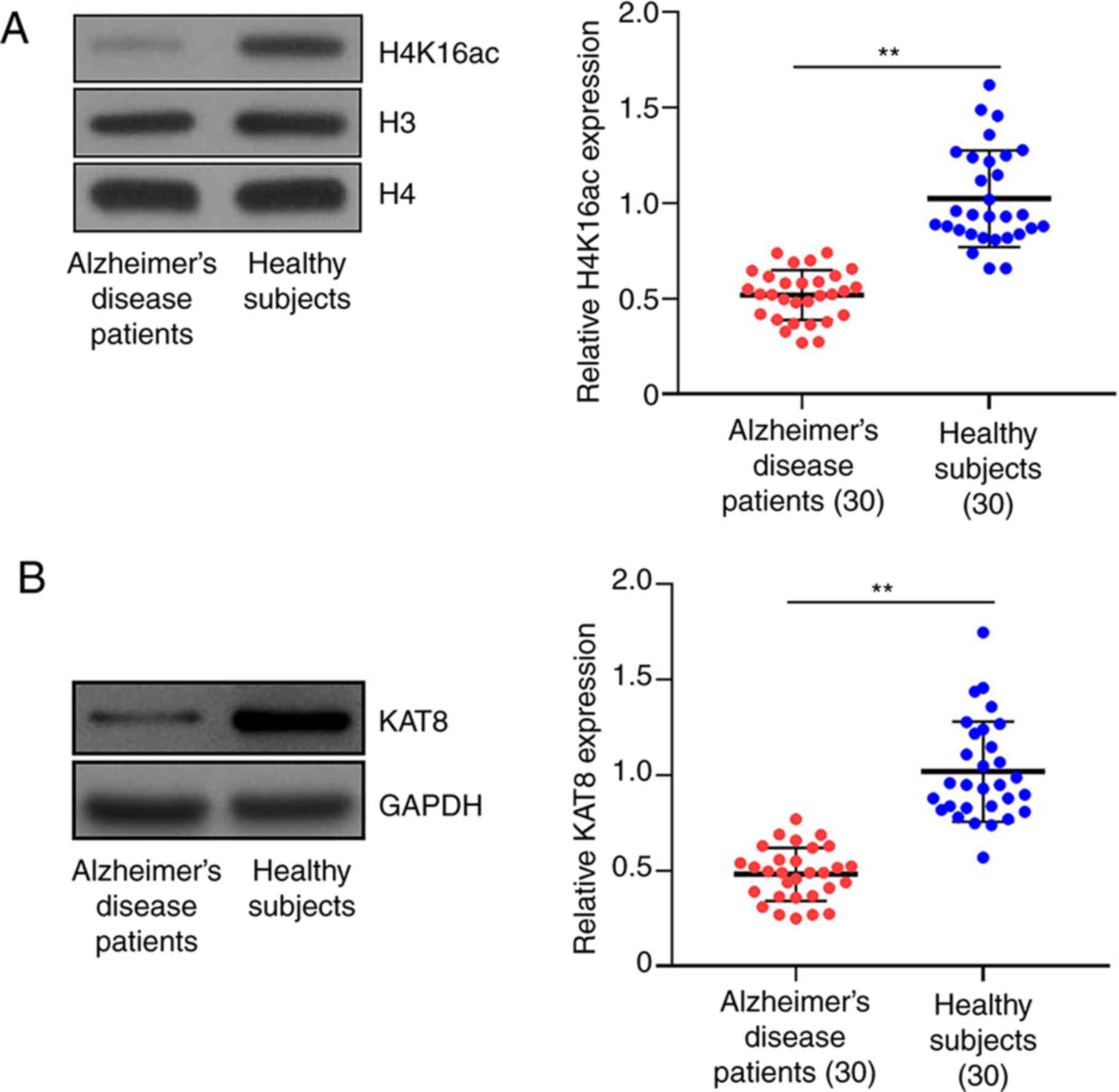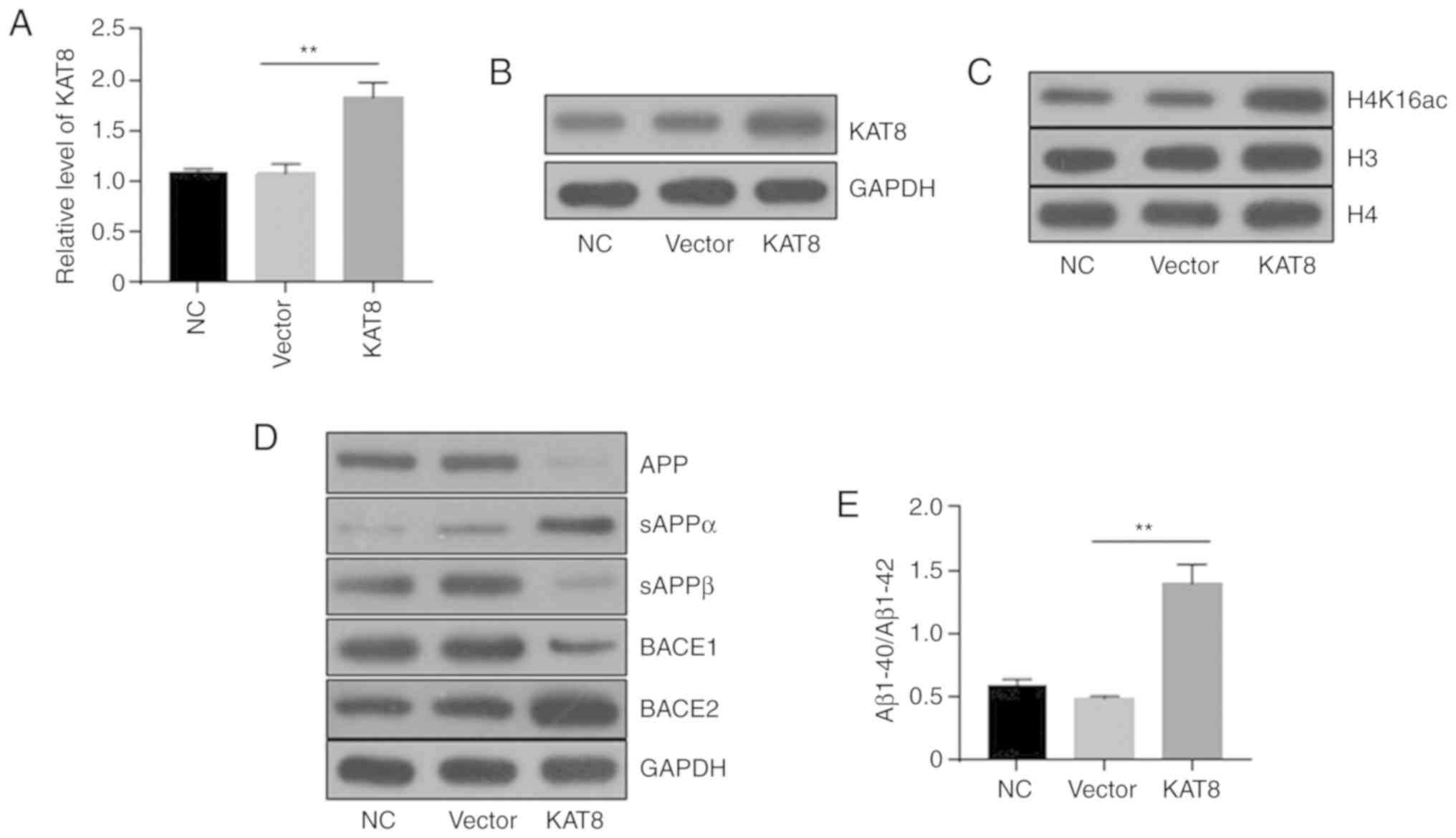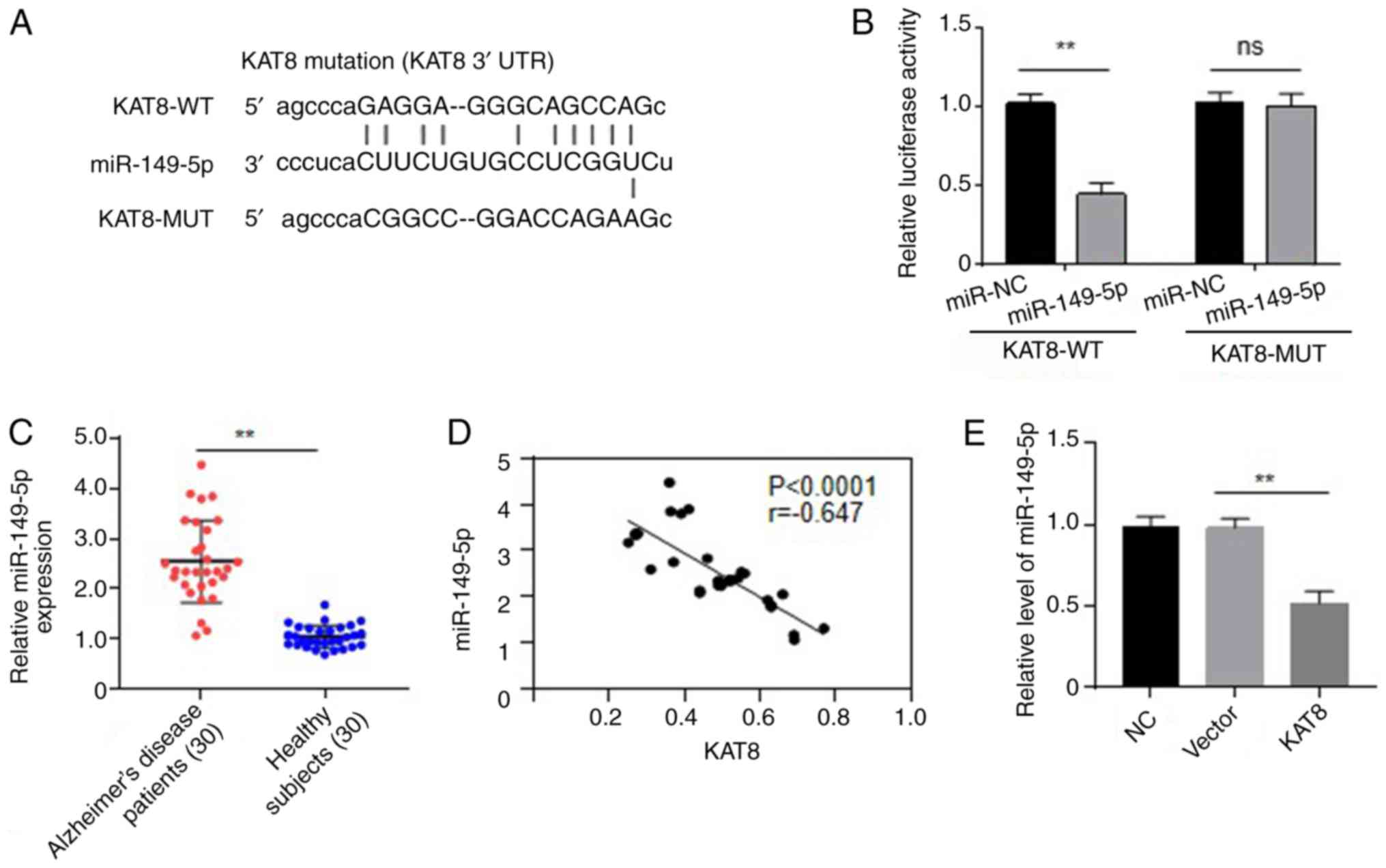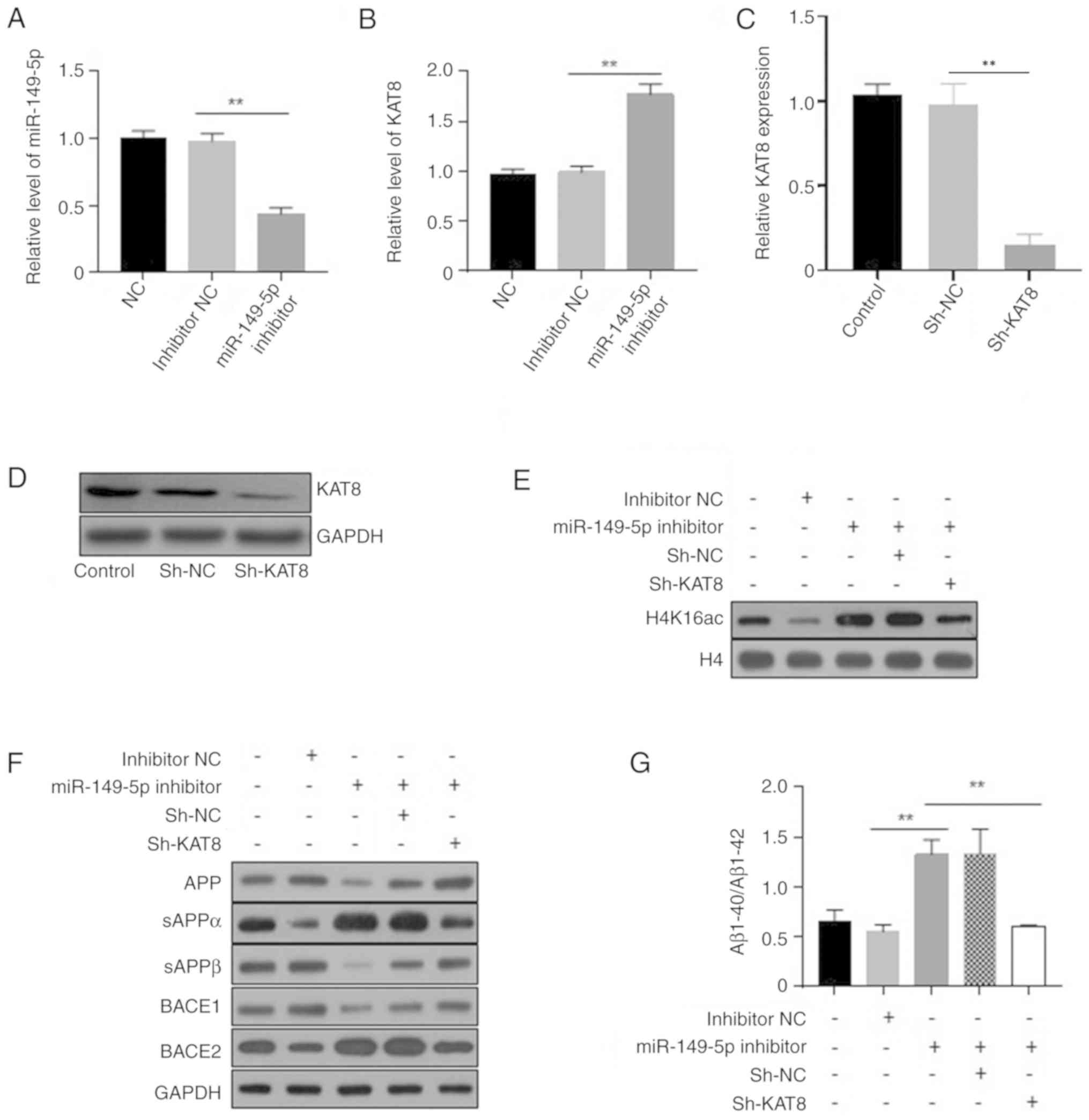|
1
|
Nelson PT, Braak H and Markesbery WR:
Neuropathology and cognitive impairment in Alzheimer disease: A
complex but coherent relationship. J Neuropathol Exp Neurol.
68:1–14. 2009.PubMed/NCBI View Article : Google Scholar
|
|
2
|
Gouras GK, Olsson TT and Hansson O:
β-Amyloid peptides and amyloid plaques in Alzheimer's disease.
Neurotherapeutics. 12:3–11. 2015.PubMed/NCBI View Article : Google Scholar
|
|
3
|
Hussain I, Powell D, Howlett DR, Tew DG,
Meek TD, Chapman C, Gloger IS, Murphy KE, Southan CD, Ryan DM, et
al: Identification of a novel aspartic protease (Asp 2) as
beta-secretase. Mol Cell Neurosci. 14:419–427. 1999.PubMed/NCBI View Article : Google Scholar
|
|
4
|
Yan R, Bienkowski MJ, Shuck ME, Miao H,
Tory MC, Pauley AM, Brashier JR, Stratman NC, Mathews WR, Buhl AE,
et al: Membrane-anchored aspartyl protease with Alzheimer's disease
beta-secretase activity. Nature. 402:533–537. 1999.PubMed/NCBI View
Article : Google Scholar
|
|
5
|
Ourdev D, Foroutanpay BV, Wang Y and Kar
S: The effect of Aβ1-42 oligomers on APP processing and Aβ1-40
generation in cultured U-373 astrocytes. Neurodegener Dis.
15:361–368. 2015.PubMed/NCBI View Article : Google Scholar
|
|
6
|
Zhang YW, Thompson R, Zhang H and Xu H:
APP processing in Alzheimer's disease. Mol Brain.
4(3)2011.PubMed/NCBI View Article : Google Scholar
|
|
7
|
Kapsimali M, Kloosterman WP, de Bruijn E,
Rosa F, Plasterk RH and Wilson SW: MicroRNAs show a wide diversity
of expression profiles in the developing and mature central nervous
system. Genome Biol. 8(R173)2007.PubMed/NCBI View Article : Google Scholar
|
|
8
|
Konopka W, Kiryk A, Novak M, Herwerth M,
Parkitna JR, Wawrzyniak M, Kowarsch A, Michaluk P, Dzwonek J,
Arnsperger T, et al: MicroRNA loss enhances learning and memory in
mice. J Neurosci. 30:14835–14842. 2010.PubMed/NCBI View Article : Google Scholar
|
|
9
|
Li J and Wang H: miR-15b reduces amyloid-β
accumulation in SH-SY5Y cell line through targetting NF-κB
signaling and BACE1. Biosci Rep. 38(BSR20180051)2018.PubMed/NCBI View Article : Google Scholar
|
|
10
|
Santa-Maria I, Alaniz ME, Renwick N, Cela
C, Fulga TA, Van Vactor D, Tuschl T, Clark LN, Shelanski ML, McCabe
BD and Crary JF: Dysregulation of microRNA-219 promotes
neurodegeneration through post-transcriptional regulation of tau. J
Clin Invest. 125:681–686. 2015.PubMed/NCBI View
Article : Google Scholar
|
|
11
|
Ruan D, Liu Y, Wang X, Yang D and Sun Y:
miR-149-5p protects against high glucose-induced pancreatic beta
cell apoptosis via targeting the BH3-only protein BIM. Exp Mol
Pathol. 110(104279)2019.PubMed/NCBI View Article : Google Scholar
|
|
12
|
Xiang F, Fan Y, Ni Z, Liu Q, Zhu Z, Chen
Z, Hao W, Yue H, Wu R and Kang X: Ursolic acid reverses the
chemoresistance of breast cancer cells to paclitaxel by targeting
miRNA-149-5p/MyD88. Front Oncol. 9(501)2019.PubMed/NCBI View Article : Google Scholar
|
|
13
|
Lu H, Liu X, Deng Y and Qing H: DNA
methylation, a hand behind neurodegenerative diseases. Front Aging
Neurosci. 5(85)2013.PubMed/NCBI View Article : Google Scholar
|
|
14
|
Mastroeni D, Grover A, Delvaux E,
Whiteside C, Coleman PD and Rogers J: Epigenetic mechanisms in
Alzheimer's disease. Neurobiol Aging. 32:1161–1180. 2011.PubMed/NCBI View Article : Google Scholar
|
|
15
|
Aubry S, Shin W, Crary JF, Lefort R,
Qureshi YH, Lefebvre C, Califano A and Shelanski ML: Assembly and
interrogation of Alzheimer's disease genetic networks reveal novel
regulators of progression. PLoS One. 10(e0120352)2015.PubMed/NCBI View Article : Google Scholar
|
|
16
|
Min SW, Cho SH, Zhou Y, Schroeder S,
Haroutunian V, Seeley WW, Huang EJ, Shen Y, Masliah E, Mukherjee C,
et al: Acetylation of tau inhibits its degradation and contributes
to tauopathy. Neuron. 67:953–966. 2010.PubMed/NCBI View Article : Google Scholar
|
|
17
|
Lu X, Deng Y, Yu D, Cao H, Wang L, Liu L,
Yu C, Zhang Y, Guo X and Yu G: Histone acetyltransferase p300
mediates histone acetylation of PS1 and BACE1 in a cellular model
of Alzheimer's disease. PLoS One. 9(e103067)2014.PubMed/NCBI View Article : Google Scholar
|
|
18
|
Marques SC, Lemos R, Ferreiro E, Martins
M, de Mendonça A, Santana I, Outeiro TF and Pereira CM: Epigenetic
regulation of BACE1 in Alzheimer's disease patients and in
transgenic mice. Neuroscience. 220:256–266. 2012.PubMed/NCBI View Article : Google Scholar
|
|
19
|
Peleg S, Sananbenesi F, Zovoilis A,
Burkhardt S, Bahari-Javan S, Agis-Balboa RC, Cota P, Wittnam JL,
Gogol-Doering A, Opitz L, et al: Altered histone acetylation is
associated with age-dependent memory impairment in mice. Science.
328:753–756. 2010.PubMed/NCBI View Article : Google Scholar
|
|
20
|
Walker MP, LaFerla FM, Oddo SS and Brewer
GJ: Reversible epigenetic histone modifications and Bdnf expression
in neurons with aging and from a mouse model of Alzheimer's
disease. Age (Dordr). 35:519–531. 2013.PubMed/NCBI View Article : Google Scholar
|
|
21
|
Lau P, Frigerio CS and De Strooper B:
Variance in the identification of microRNAs deregulated in
Alzheimer's disease and possible role of lincRNAs in the pathology:
The need of larger datasets. Ageing Res Rev. 17:43–53.
2014.PubMed/NCBI View Article : Google Scholar
|
|
22
|
Goldberg AD, Allis CD and Bernstein E:
Epigenetics: A landscape takes shape. Cell. 128:635–638.
2007.PubMed/NCBI View Article : Google Scholar
|
|
23
|
Kouzarides T: Chromatin modifications and
their function. Cell. 128:693–705. 2007.PubMed/NCBI View Article : Google Scholar
|
|
24
|
Yamakawa H, Cheng J, Penney J, Gao F,
Rueda R, Wang J, Yamakawa S, Kritskiy O, Gjoneska E and Tsai LH:
The transcription factor Sp3 cooperates with HDAC2 to regulate
synaptic function and plasticity in neurons. Cell Rep.
20:1319–1334. 2017.PubMed/NCBI View Article : Google Scholar
|
|
25
|
Chuang DM, Leng Y, Marinova Z, Kim HJ and
Chiu CT: Multiple roles of HDAC inhibition in neurodegenerative
conditions. Trends Neurosci. 32:591–601. 2009.PubMed/NCBI View Article : Google Scholar
|
|
26
|
Gräff J and Mansuy IM: Epigenetic
dysregulation in cognitive disorders. Eur J Neurosci. 30:1–8.
2009.PubMed/NCBI View Article : Google Scholar
|
|
27
|
Sharma GG, So S, Gupta A, Kumar R, Cayrou
C, Avvakumov N, Bhadra U, Pandita RK, Porteus MH, Chen DJ, et al:
MOF and histone H4 acetylation at lysine 16 are critical for DNA
damage response and double-strand break repair. Mol Cell Biol.
30:3582–3595. 2010.PubMed/NCBI View Article : Google Scholar
|
|
28
|
Marioni RE, Harris SE, Zhang Q, McRae AF,
Hagenaars SP, Hill WD, Davies G, Ritchie CW, Gale CR, Starr JM, et
al: GWAS on family history of Alzheimer's disease. Transl
Psychiatry. 8(99)2018.PubMed/NCBI View Article : Google Scholar
|
|
29
|
Chatterjee A, Seyfferth J, Lucci J,
Gilsbach R, Preissl S, Böttinger L, Mårtensson CU, Panhale A,
Stehle T, Kretz O, et al: MOF acetyl transferase regulates
transcription and respiration in mitochondria. Cell. 167:722–738
e723. 2016.PubMed/NCBI View Article : Google Scholar
|
|
30
|
Guo R, Fan G, Zhang J, Wu C, Du Y, Ye H,
Li Z, Wang L, Zhang Z, Zhang L, et al: A 9-microRNA signature in
serum serves as a noninvasive biomarker in early diagnosis of
Alzheimer's disease. J Alzheimers Dis. 60:1365–1377.
2017.PubMed/NCBI View Article : Google Scholar
|
|
31
|
Tamaoka A: Alzheimer's disease: Definition
and national institute of neurological and communicative disorders
and stroke and the Alzheimer's disease and related disorders
association (NINCDS-ADRDA). Nihon Rinsho. 2 (Suppl 69):S240–S245.
2011.PubMed/NCBI(In Japanese).
|
|
32
|
Haris M, Singh A, Cai K, McArdle E, Fenty
M, Davatzikos C, Trojanowski JQ, Melhem ER, Clark CM and Borthakur
A: T(1p) MRI in Alzheimer's disease: Detection of pathological
changes in medial temporal lobe. J Neuroimaging. 21:e86–e90.
2011.
|
|
33
|
Reichenberg A, Harvey PD, Bowie CR,
Mojtabai R, Rabinowitz J, Heaton RK and Bromet E:
Neuropsychological function and dysfunction in schizophrenia and
psychotic affective disorders. Schizophr Bull. 35:1022–1029.
2009.PubMed/NCBI View Article : Google Scholar
|
|
34
|
Livak KJ and Schmittgen TD: Analysis of
relative gene expression data using real-time quantitative PCR and
the 2(-Delta Delta C(T)) method. Methods. 25:402–408.
2001.PubMed/NCBI View Article : Google Scholar
|
|
35
|
Mews P, Donahue G, Drake AM, Luczak V,
Abel T and Berger SL: Acetyl-CoA synthetase regulates histone
acetylation and hippocampal memory. Nature. 546:381–386.
2017.PubMed/NCBI View Article : Google Scholar
|
|
36
|
Gräff J and Tsai LH: The potential of HDAC
inhibitors as cognitive enhancers. Annu Rev Pharmacol Toxicol.
53:311–330. 2013.PubMed/NCBI View Article : Google Scholar
|
|
37
|
Levenson JM, O'Riordan KJ, Brown KD, Trinh
MA, Molfese DL and Sweatt JD: Regulation of histone acetylation
during memory formation in the hippocampus. J Biol Chem.
279:40545–40559. 2004.PubMed/NCBI View Article : Google Scholar
|
|
38
|
Basi G, Frigon N, Barbour R, Doan T,
Gordon G, McConlogue L, Sinha S and Zeller M: Antagonistic effects
of beta-site amyloid precursor protein-cleaving enzymes 1 and 2 on
beta-amyloid peptide production in cells. J Biol Chem.
278:31512–31520. 2003.PubMed/NCBI View Article : Google Scholar
|
|
39
|
Sun X, He G and Song W: BACE2, as a novel
APP theta-secretase, is not responsible for the pathogenesis of
Alzheimer's disease in down syndrome. FASEB J. 20:1369–1376.
2006.PubMed/NCBI View Article : Google Scholar
|
|
40
|
Lu TX and Rothenberg ME: MicroRNA. J
Allergy Clin Immunol. 141:1202–1207. 2018.PubMed/NCBI View Article : Google Scholar
|
|
41
|
Zetterberg H and Burnham SC: Blood-based
molecular biomarkers for Alzheimer's disease. Mol Brain.
12(26)2019.PubMed/NCBI View Article : Google Scholar
|
|
42
|
Gräff J, Rei D, Guan JS, Wang WY, Seo J,
Hennig KM, Nieland TJF, Fass DM, Kao PF, Kahn M, et al: An
epigenetic blockade of cognitive functions in the neurodegenerating
brain. Nature. 483:222–226. 2012.PubMed/NCBI View Article : Google Scholar
|
|
43
|
Dorszewska J, Prendecki M, Oczkowska A,
Dezor M and Kozubski W: Molecular basis of familial and sporadic
Alzheimer's disease. Curr Alzheimer Res. 13:952–963.
2016.PubMed/NCBI View Article : Google Scholar
|
|
44
|
Wang L, Liu J, Wang Q, Jiang H, Zeng L, Li
Z and Liu R: MicroRNA-200a-3p mediates neuroprotection in
Alzheimer-related deficits and attenuates amyloid-beta
overproduction and tau hyperphosphorylation via coregulating BACE1
and PRKACB. Front Pharmacol. 10(806)2019.PubMed/NCBI View Article : Google Scholar
|
|
45
|
Long JM, Ray B and Lahiri DK:
MicroRNA-339-5p down-regulates protein expression of β-site amyloid
precursor protein-cleaving enzyme 1 (BACE1) in human primary brain
cultures and is reduced in brain tissue specimens of Alzheimer
disease subjects. J Biol Chem. 289:5184–5198. 2014.PubMed/NCBI View Article : Google Scholar
|
|
46
|
Jia LH and Liu YN: Downregulated serum
miR-223 servers as biomarker in Alzheimer's disease. Cell Biochem
Funct. 34:233–237. 2016.PubMed/NCBI View Article : Google Scholar
|
|
47
|
Kumar S, Vijayan M and Reddy PH:
MicroRNA-455-3p as a potential peripheral biomarker for Alzheimer's
disease. Hum Mol Genet. 26:3808–3822. 2017.PubMed/NCBI View Article : Google Scholar
|
|
48
|
Zhang B, Chen CF, Wang AH and Lin QF:
miR-16 regulates cell death in Alzheimer's disease by targeting
amyloid precursor protein. Eur Rev Med Pharmacol Sci. 19:4020–4027.
2015.PubMed/NCBI
|
|
49
|
Chen W, Zhang J, Xu H, Dai J and Zhang X:
The negative regulation of miR-149-5p in melanoma cell survival and
apoptosis by targeting LRIG2. Am J Transl Res. 9:4331–4340.
2017.PubMed/NCBI
|
|
50
|
Xu RD, Feng F, Yu XS, Liu ZD and Lao LF:
miR-149-5p inhibits cell growth by regulating TWEAK/Fn14/PI3K/AKT
pathway and predicts favorable survival in human osteosarcoma. Int
J Immunopathol Pharmacol. 32(2058738418786656)2018.PubMed/NCBI View Article : Google Scholar
|
|
51
|
Sundermann EE, Heaton RK, Pasipanodya E,
Moore RC, Paolillo EW, Rubin LH, Ellis R, Moore DJ and Group HNRP:
Sex differences in HIV-associated cognitive impairment. AIDS.
32:2719–2726. 2018.PubMed/NCBI View Article : Google Scholar
|
|
52
|
Norman MA, Moore DJ, Taylor M, Franklin D
Jr, Cysique L, Ake C, Lazarretto D, Vaida F, Heaton RK and Group
HNRC: Demographically corrected norms for African Americans and
caucasians on the hopkins verbal learning test-revised, brief
visuospatial memory test-revised, stroop color and word test, and
wisconsin card sorting test 64-card version. J Clin Exp
Neuropsychol. 33:793–804. 2011.PubMed/NCBI View Article : Google Scholar
|


















